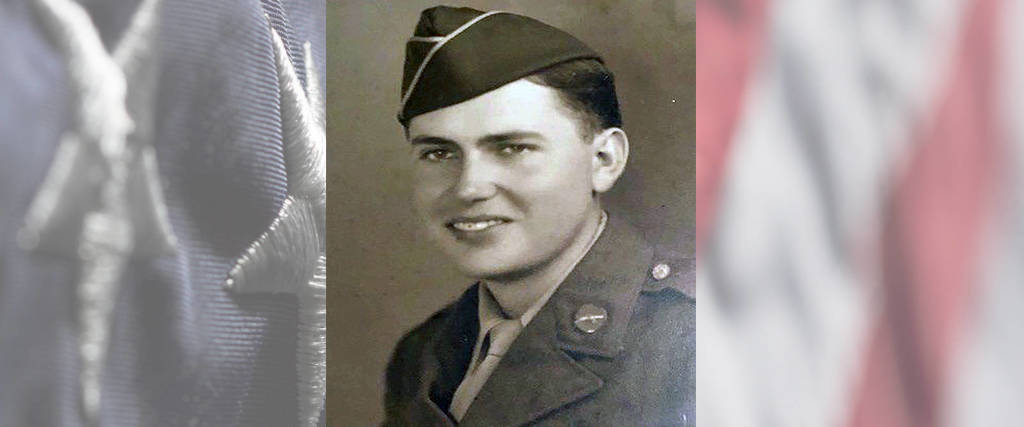U.S. Army World War II Naperville, IL Flight date: October, 2019
By Charlie Souhrada, Honor Flight Chicago Veteran Interviews Volunteer
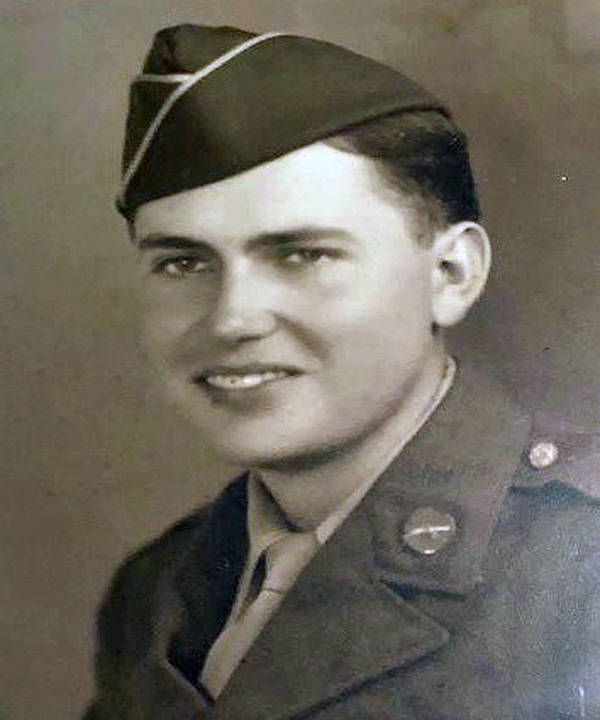
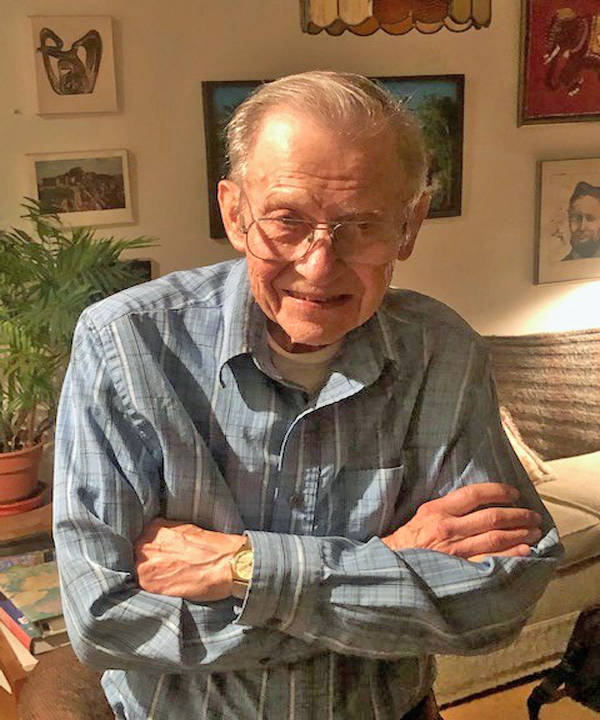
Joe Ayres was a student at Northeast Missouri State Teachers College (now known as Truman State University) when the United States formally entered World War II. Two years later, he enlisted in the Army and played a role in three critical battles that helped end the war in Europe. On October 16, 2019, more than seven decades later, he will join Honor Flight Chicago on a trip to Washington, D.C., to honor his service and to remember.
Born in 1923, Joe grew up on his family’s farm near Atlanta, Missouri, a town with less than 500 people. As the youngest child of Joe H. and Lyda Ayres, his life centered on farm chores and attending school with his older sisters, Martha and Amy. “We were expected to get home, get our chores done and then we were free to find something to do,” he remembers. “My dad didn’t work us too hard and, despite the fact that it was hard to find people to play with, life on the farm was pleasant enough.”
The Ayres’ farm produced a little bit of everything – beans, corn, oats and wheat – with a small livestock operation, where Joe was responsible for feeding the hogs. “My dad managed to make a living of it and sent all three of us off to college.”
World War II broke out during Joe’s freshman year at college. Initially, he tried to join the Navy, but was turned down because he didn’t have the engineering experience that the Navy wanted. Also, he was still a student and his labor was needed on the family farm. As the war escalated, Joe watched his friends leave in waves to join the fight. He realized that he didn’t want to stay on the farm during wartime. In fall 1943, he took matters into his own hands and enlisted in the Army. “I figured it was the largest branch with more opportunity and they would be able to use me for whatever they needed.”
He began Basic Training in October 1943, at the Jefferson Barracks Military Post in Lemay, Missouri, near St. Louis. “At the end of Basic, I remember telling an officer that I could take shorthand and type. He told me, ‘Sorry, we need riflemen’ and sent me to Ft. Benning, Georgia, and then eventually Ft. Jackson, South Carolina, for weapons training.”
During specialty training, Joe quickly realized hand-to-hand combat wasn’t his strong suit. “I remember telling an officer that if he ever caught me in a bayonet fight, he would know it was a mistake!” Instead, a one-in-a-million shot helped him earn a spot on a heavy weapons mortar squad. “I got really lucky and hit a target on my first try. I think that may have affected my placement!”
In fall 1944, Joe received orders to ship out and fill ranks overseas. After a brief furlough visit to explore Washington, D.C., he reported to Camp Myles Standish in Taunton, Massachusetts, and left for Europe aboard the USS Mount Vernon (AP-22), a luxury liner converted into a troopship. He landed in Liverpool, traveled across England by train and, after a brief troopship voyage, ended up on Omaha Beach, four months after the D-Day invasion of Normandy, France. From Normandy, he traveled by truck convoy to Nancy, France, where he was assigned to a mortar squad with the 35th Division.
As a member of an 81mm mortar squad, Joe’s job was to supply the shells that would keep the gun loaded. From September, 1944, until the end of the war in Europe, he served on the firing line. When possible, his regiment would get pulled off the line for some brief rest and relaxation; then they would go back and do it all over again.
“I remember it was a wet year and every foxhole was full of water. On my first day on the front lines, I was assigned to an outfit that had dug foxholes into the side of a hill. In the middle of the night, the squad leader, who was sharing his foxhole with me, woke me up because our foxhole was collapsing in on us. We crawled out and spent the rest of the night in the open with shells whistling overhead.”
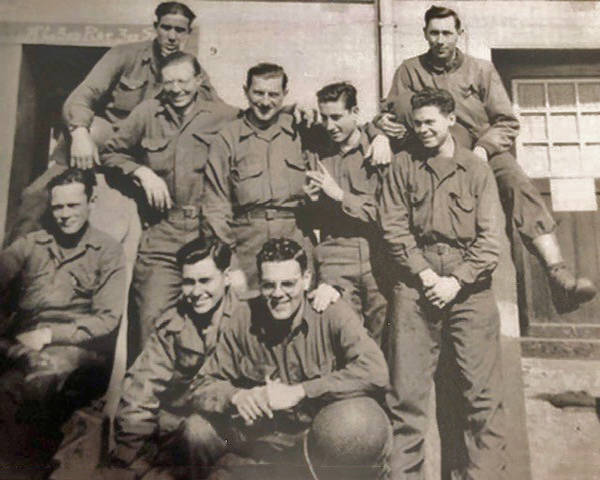
Because mortar squads were typically positioned about one mile behind the front lines, Joe explains that incoming enemy shells were the principal combat he experienced. In particular, he learned to listen for the German army’s 88 mm anti-aircraft and anti-tank artillery which were very accurate and known to wreak havoc.
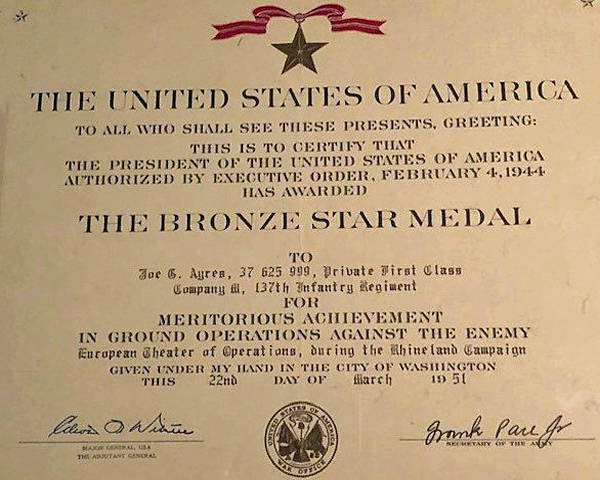
During his tour of duty, Joe earned battle stars for his role in three, key battles: the Battle of the Bulge, Battle of the Rhineland, and Battle of Central Europe. He also was awarded the Bronze Star Medal for meritorious service in a combat zone.
After Germany surrendered in May 1945, Joe was assigned to serve near Hanover, Germany. He was eventually transferred to Camp Lucky Strike, where he expected to be shipped to Japan to enter the Pacific Theater. Those expectations changed in August when Japan surrendered to the Allies, effectively ending World War II. Joe was sent back to the states and was discharged in November.
At that time of the year, the crops were in and life on the family farm was slow, so Joe resumed his studies at the University of Iowa in Iowa City. One day at the university, Joe met with a recruiter from Western Electric. That meeting resulted in a position in the company’s management training program, which brought him to Chicago.
Following his time in the service, Joe’s relationship with Audrey, a young girl he met at college before the war, began to blossom. “We corresponded all during the war,” he remembers. “She called me one day, invited me to a picnic and things took off from there!” The couple married on June 6, 1946 – two years after D-Day, Joe likes to point out. Later that same year, the couple bought a house in Lombard and Joe joined Illinois Bell where he spent his entire career until retiring in 1985.
In the early 1950’s, Joe and Audrey moved to Naperville to provide more room for their growing family of three sons and one daughter: Peter, Michael, John and Martha. Sadly, Audrey passed away in 2008. Joe now shares the couple’s second Naperville home with his son Peter and grandson, Nick. Together they enjoy the sprawling, two-acre lot filled with trees, flowers and gardens that Audrey loved. “I spend a lot of time keeping the yard and the house up to snuff,” Joe laughs. “It’s a full-time job!” His children Mike, John and Martha all live close by.



